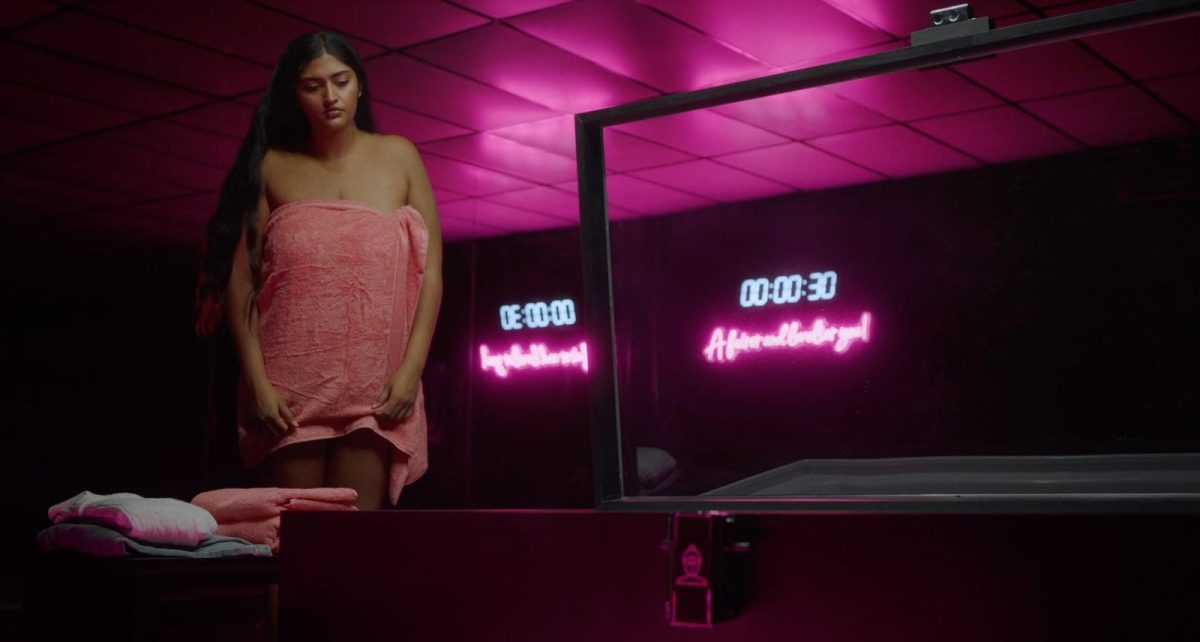Audre Lorde, in her “Sister Outsider,” notes that amidst the tendency of white women drawing the map of what it entails to be a woman based on their experiences alone, it is the women of colour who become ‘other’: their experiences become too alien to comprehend. Such a proclamation echoes abundantly in Urvashi Pathania’s latest short, “Skin” (2025).
The central contention of “Skin” arises from the feelings of ‘othering’ that is not only cultural but biological in its very essence. However, corporate America, confounded by this ‘’otherness,’ tries to tame it. “Skin” instead explores how Indian-American women understand themselves as citizens of and what they expect from America. The women of colour become sacrificial lambs to cater to the White woman’s youth.
It would not be too much of an exaggeration if one were to claim that Pathania’s short film “Skin” is an amalgamation that is symptomatic of an overconsumption of cheap Lifetime thrillers and a nod to “The Substance.” In fact, “Skin” tries to replicate the same visual immaculateness of Coralie Fargeat’s body horror: in the common Internet parlance, a dupe for an original. However, “Skin” endows it with a unique voice for the racially disadvantaged.
In “Skin,” Kanika, an Indian-American woman, opts for a skin bleaching treatment, despite her sister’s attempt to talk her out of it. At Markandeya, an advanced skincare clinic, women of colour are led to neon-lit rooms with a coffin-like tank, where they immerse themselves in a milky white liquid. The result? They become several shades lighter.
The director assures that the formulation is gentle and harmless. She even questions Kanika if any coercion was involved behind her decision. Kanika denies being influenced by anybody; she simply wants to look like her mother, who was fair. The timer is set for 30 seconds. Following the immersion process, the coffin opens, and the client steps out with a new self.
However, despite the assurance, the spectators know that the process is not innocuous. In their pursuit of getting rid of their natural melanin, the women are pushed to the brink, and their melanin is usurped without their knowledge. The capitalist cosmetologists bottle the ‘fountain of youth’ and sell it to their kind: the aging white women. Even the rooms of the clinic are designed in accordance with the client’s needs. Women of colour are led to a room where a white liquid fills the tank. Their melanin is drawn out and is passed on through a pipe to a similar coffin placed in an attached room.

The White women visit this room— the neon lights read ‘A tanner and younger you’– and the inlet pipe passes a liquid that resembles a darker shade of foundation. As Beauty influencer Ria, Kanika’s sister, goes on an angry tirade against the hypocrisy of the beauty industry on her page, she is warned against the beauty clinic by one of her followers. When she tries to find Kanika, she is caught in the maze of the structure. Even as Kanika is spared momentarily, Ria sacrifices herself in the end.
Before we see Ria’s almost lifeless body floating and screaming for help in a faint voice in the end, we see a long queue of women, much older, waiting to take a dip in this fountain of youth. Ria is trapped, and the entire supply of melanin in her body is sucked out to cater to these women. What we are presented with is a haunting recapitulation of racism, a subdued cry against pillaging, capitalism, and white patriarchal dominance of women in America.
In the film, the tightness of the spaces folding in contributes to a singular stifling sense. The space of the film is disorienting: there is no sense of a clear, concise mapping of the corporate structure. The interiors of the clinic evoke a sense of a dreadful maze or even a bottomless pit. What contributes more to this feeling is the ample use of tight close-up shots.
In that sense, the horror lies in how an array of phobias is touched upon throughout the film. Additionally, the lighting sets the mood for the dystopian reality: the neon glow signs are characters of their own. Paralleling the melanin-tinged substance, an orange lighting sets the tone in the room meant for the white women. Similarly, a neon glow is consciously chosen to complement the dark-skinned women in the other room.
There is a kind of constraint that seems to be holding Pathania’s film back from leaping into something more shocking or even more memorable, beyond just being imitative. The theme would have felt novel ten years back. However, given the increased attention to women’s experience of horror, “Skin” relies too heavily on its successful predecessors to work as its wind beneath the sails. Yet, it presents an undeniable, incisive commentary on society’s obsession with beauty.







